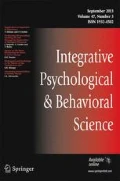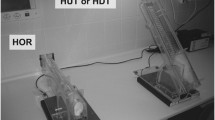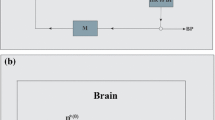Summary
-
1.
During habituation in 4 dogs to a new environment and attachment of apparatus, the blood pressure was at first high but fell from about 175 systolic the first day to about 135 on the ninth day.
-
2.
In the first group of dogs used two years previously to form 3 cardiac conditional reflexes to 3 intensities of shock, the blood pressure measured after a 13-month rest was retained and specific to the 3 intensities of shock. In another group of 2 dogs the blood pressure was specific to the excitatory and to the inhibitory signals for pain.
-
3.
The conditioned hypertension was parallel to the conditioned heart rate.
-
4.
The conditioned hypertension was parallel to the motor conditional reflex with certain exceptions: the conditioned hypertension was, like the cardiac conditional reflex, quicker to form and more persistent, thus being present often in the absence of the motor conditional reflex—an evidence ofschizokinesis.
-
5.
The conditioned hypertension was retained for a 13-month rest period without intervening training, being present immediately when the dog was brought back into the environment where the stress had been given.
-
6.
Although the conditioned hypertension was retained in the long rest period,it could in one dog be reduced somewhat by repeating the conditional stimulus without the shock (non-reinforcement), a more efficient way of extinction than simple rest. In another dog the hypertension became exaggerated though there was no repetition of the stress, showing evidence of an internal development (autokinesis).
-
7.
The amplitude of the conditioned hypertension varied according to the individual dog from about 130 average control to limits of 150 to 225 (conditioned hypertension) in the separate dogs.
Similar content being viewed by others
References
Allen, F. M. (1923). Auscultatory estimation of blood pressure of dogs.J. Metab. Research, 4:431.
Beier, D. C. (1940). Conditioned cardiovascular responses and suggestions for the treatment of cardiac neuroses.J. Exper. Psychol., 26: 311.
Best, Charles H. and Taylor, Norman B. (1955).Physiological Basis of Medical Practise. Baltimore: The Williams & Wilkins Co.
Bykov, K. M. (1957).Cerebral Cortex and Internal Organs. Edited and Translated by W. Horsley Gantt. New York: Chemical Publishing Co., p. 448.
Burch, George. Personal Communication.
Dykman, Roscoe A. and Gantt, W. Horsley. (1956). Relation of experimental tachycardia to amplitude of motor activity and intensity of the motivating stimulus.Am. J. Physiol., 185:3.
Dykman, Roscoe A. (1958). Cardiovascular conditioning in dogs and in humans. InPhysiological Bases of Psychiatry. Edited by W. Horsley Gantt. Springfield, Ill.: Charles C. Thomas.
Fronkova, K. and Slegr, L. (1955). Prispevek methodice plynule nekrvave registrace tlaku krevniho.Ceskoslovenska Fysiologie, rocnik IV—cislo 4.
Gantt, W. Horsley, Hoffmann, W. C., and Dworkin, S. (1947). The cardiac conditional reflex. XVII International Physiol. Cong., July 21–25,Absts. of Communicat., 15.
Gantt, W. Horsley. (1953). The physiological basis of psychiatry: The conditional reflex. InBasic Problems in Psychiatry. Edited by J. Wortis. New York: Grune & Stratton, pp. 52–89.
Gantt, W. Horsley. (1948). Physiological psychology.Ann. Rev. Physiol., 10: 453.
Garvey, E. R. (1933). A study of conditioned respiratory changes.J. Exper. Psychol., 4:471.
Girden, E. (1942). The dissociation of blood pressure conditioned responses under erythroiodine. 1.Exper. Psychol., 31: 219.
Idem and Dykman, Roscoe A. (1957). Experimental psychogenic tachycardia. In:Experimental Psychopathology. New York: Crune & Stratton, p. 12.
Idem And Hoffmann, W. Christie. (1940). Conditioned cardio-respiratory changes accompanying conditioned food reflexes.Am. J. Physiol., 129: 2, 360.
Idem. (1953). Principles of nervous breakdown—schizokinesis and autokinesis.Ann. Acad. Sc., 56: 2, 143.
Idem. (1944).Experimental Basis for Neurotic Behavior. New York: Hoeber & Co.
Korneva and Abdullin. (1957). Demonstration to the author in Leningrad, September.
Pavlov, I. P. (1894). Uber die normalen blutdruckschwankungen beim hunde.Arch. ges. Physiol., 20: 215.
Pavlov, I.P. (1904). Uber die normalen blutdruckschwankungen beim hunde.Arch. sc. biol., 11: 93.
Reese, Wm. G., Doss, Richard And Gantt, W. Horsley. (1953). Autonomic responses in differential diagnosis of organic and psychogenic psychoses.A. M. A. Arch. Neurol. & Psychiat., 70: 788.
Robinson, J. and Gantt, W. Horsley. (1947). The orienting reflex (questioning reaction): Cardiac, respiratory, salivary and motor components.Bull. Johns Hopkins Hosp., 80:231.
Scott, H. D. (1930). Hypnosis and the conditional reflex.J. Gen. Psychol., 4: 113.
Stephens, Joseph H. and Gantt, W. Horsley. (1956). The differential effect of morphine on cardiac and motor conditional reflexes-schizokinesis.Bull. Johns Hopkins Hosp., 98: 245.
Simonson, Ernst and Brozek, Josef (1959). Russian research on arterial hypertension.Ann. Int. Med., 50: 1, 120.
Tigerstedt, C. (1926). Der Blutdruck des Menschen bei psychischer Excitation.Skand. Arch. Physiol., 48: 138.
Watson, J. B. (1926). The place of the conditioned reflex in psychology.Psychol. Rev., 23:80.
Wiggers, C. J. (1951).Physiology in Health and Disease. Philadelphia: Lea & Febiger.
Wilhelmj, C.M., Mcguire, I.F., Mcdonough, J., Waldmann, E.B. and McCarthy, H.H. (1953). Emotional elevation of blood pressure in trained dogs.Psychosom. Med., 15:390.
Author information
Authors and Affiliations
Additional information
Reprinted fromBulletin of the Johns Hopkins Hospital, Vol. 107, No. 2, pp. 72–89, August, 1960.
Rights and permissions
About this article
Cite this article
Dykman, R.A., Gantt, W.H. Experimental psychogenic hypertension: Blood pressure changes conditioned to painful stimuli (Schizokinesis). Integrative Physiological and Behavioral Science 32, 272–287 (1997). https://doi.org/10.1007/BF02688625
Issue Date:
DOI: https://doi.org/10.1007/BF02688625




